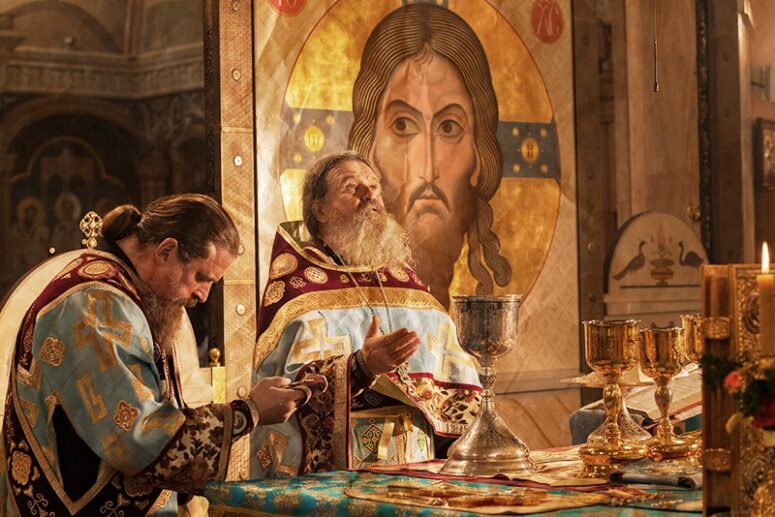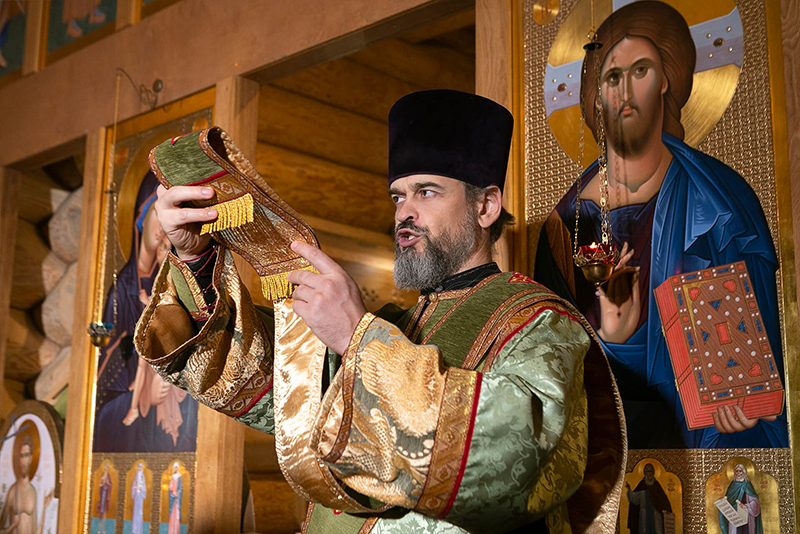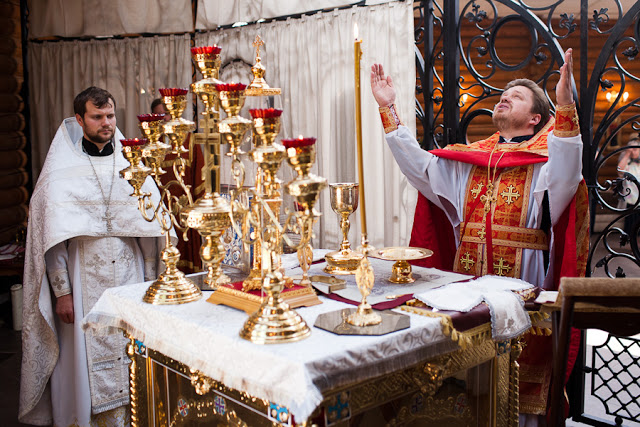
The Anaphora (or the Eucharistic canon) is the main set of prayers offered by the priest during Liturgy. Its purpose is asking God to send His grace onto the holy gifts and transubstantiate them into the Body and Blood of Christ. In the modern practice of the Orthodox Church, the priest reads these prayers “secretly”, making them inaudible to the parishioners. This however has not always been the case. The idea of reviving the practice of reading the “secret” prayers publicly is quite common. How did this practice begin? Can it return? Let’s look at the history of the Church.
The ancient period in the formation of the priestly prayers during liturgy can be divided into three stages, i. e., before the 2nd century, 2nd – mid 4th century and from the end of the 4th to 8th century. Three aspects of the liturgical prayers were gradually changing in these periods of time. First, the prayers went from impromptu to a formula, second, they became uniform, and finally, their recitation went from public to secret.
In the period before the second century, Christianity was still taking shape. There is no information about any generally accepted liturgical prayers during this period, but, according to Professor Allan Bouley, the liturgical prayers were extemporized (From Freedom to Formula: The Evolution of the Eucharistic Prayer from Oral Improvisation to Written Texts). There is also no reliable information about whether these prayers were read aloud or privately, but the fact that they were read extemporaneously suggests the former.
It is known for certain that private prayers were often said aloud in antiquity. There are a number of testimonies to support this. St Nicetas of Remesianа, in his treatise On the Benefits of Hymns, exhorts his flock not to distract the reader and the congregation during the vigils by muttering private prayers out loud. “No one should pray in a voice so loud as to disturb the reader”. The Scriptures also describe cases when personal prayers were spoken aloud (Acts 8: 27-35). It is quite possible that liturgical prayers were pronounced in the same way.
Impromptu prayers remained very common until the middle of the 4th century. In the beginning of the 2nd century, uniform orders of divine services and prayers began to be distributed. Information about them can be found in the writings of Justin Martyr, Hieromartyrs Irenaeus and Ignatius, as well as in the Didache. According to the latter, the anaphora was inherently a modified version of Jewish Passover prayers said at the table. Prayer over the Chalice: “We thank you, our Father, for the holy vine of David Your servant, which You made known to us through Jesus Your Servant; to You be the glory forever”; prayer over the Bread: “We thank You, our Father, for the life and knowledge which You made known to us through Jesus Your Servant; to You be the glory forever. Even as this broken bread was scattered over the hills, and was gathered together and became one, so let Your Church be gathered together from the ends of the earth into Your kingdom; for Yours is the glory and the power through Jesus Christ forever”.
The cultural background of that period also suggested reading the recorded prayers aloud, rather than to oneself. This made the ancient texts, written without spaces or punctuation marks (from considerations of saving valuable papyrus space) much easier to understand. As can be seen from the Confessions of St Augustine, reading “to oneself” was perceived as a rare skill bordering on art.
The practice of reading prayers aloud is described in the works of several Christian writers. St Irenaeus of Lyons, in his work Adversus Haereses, criticises the Eucharistic prayers of certain Christians several times, regarding them as non-orthodox. If these prayers had been recited ‘secretly’, their content would hardly have been known.
Impromptu prayers were often misleading, since not every priest was an experienced theologian. Therefore, by the end of the 4th century, the custom of praying “in one’s own words” was completely replaced by an established body of prayers.
With the end of persecution against Christianity in the fourth century, the Church finally had the opportunity to develop freely, which led to many changes. Liturgical prayers began to be read secretly. Some Christians perceived this in a negative way.
Mar Narsai (a Nestorian writer) condemns a priest for praying secretly and says that he “communicates with God as with his acquaintance” (Homily 17). In 565, the emperor Justinian issued a decree with provisions for all liturgical prayers to be pronounced loud and clear, “so that they may be heard by the faithful, inducing the souls of the hearers to greater reverence and exalting them to the praise of the Lord God”.
However, Justinian’s decree was soon forgotten, and the earliest extant Byzantine liturgical manuscript (L’eucologio Barberini gr. 336, ca. 750), again contained instructions to read prayers secretly. In contrast to what Justinian believed, the original idea of reading prayers aloud was not to make them heard by all parishioners, but to comply with the customs existing in the Jewish and pagan environment surrounding Christians. In that environment not only public, but also private prayers were said aloud.
There were also other applied and spiritual reasons for Reading the Eucharistic prayers secretly. The former were related to the lofty language of worship, which was significantly different from the spoken language, which made it difficult for ordinary believers to follow the text of the Liturgy. In large churches, prayers said aloud by the priest were practically inaudible to the congregation, especially when the choir was singing in parallel. According to the theologian A Kashkin, the main spiritual reason was the cooling of the Eucharistic fervor among believers, hindering their ability to reverently attend to the long priestly prayers. Professor of the Moscow Theological Academy A. Golubtsov cites cases when even the Byzantine Patriarch left the liturgy after reading the Gospel (Archieratica and the Characteristics of Serving by Them, 1907).
The existence of the modern discussion about the need to preserve the secret reading, versus the introduction of the public reading, speaks of the emergence of a keen interest in liturgical life among believers. The historical experience of the Church shows that worship can be adapted to improve its perceptibility by believers. It makes sense therefore to encourage any discussion of topical issues in the liturgical field, so as to preserve in the Church the true living tradition of worship that would resonate with believers. At the same time, the appropriateness of each proposal (such as reading the “secret” prayers publicly) should be carefully considered, so as not to replace live worship with religious modernism.




